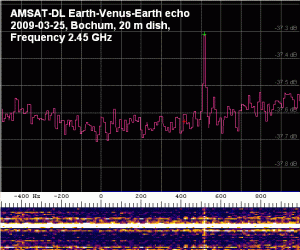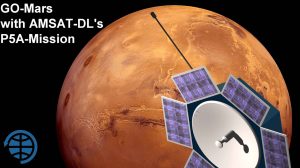On 25 March 2009 at 10:38 UTC, the team of the German space agency AMSAT-DL reached another milestone on the way to Mars with its own probe. The ground and control station at the observatory Bochum sent radio signals to Venus. After almost 100 million kilometres travelled and a runtime of about 5 minutes, they were received back in Bochum as an echo from the surface of Venus. Thus, for the first time in Germany and at least in Western Europe, it has been possible to receive echoes from other planets. At the same time, this is the greatest distance ever bridged in amateur radio, over one hundred times farther than EME (Earth-Moon-Earth) reflections.
 FFT technique with an integration time of 5 minutes was used in receiving the EVE reflections. Already after an integration time of 2 minutes the reflected signals were clearly visible. Despite showery weather, the signals from Venus could be received continuously with the 20 m antenna from 10:38 UTC until its setting in the evening.
FFT technique with an integration time of 5 minutes was used in receiving the EVE reflections. Already after an integration time of 2 minutes the reflected signals were clearly visible. Despite showery weather, the signals from Venus could be received continuously with the 20 m antenna from 10:38 UTC until its setting in the evening.
The high-power magnetron transmitter (5 kW power at 2.4 GHz) developed by AMSAT-DL itself has thus passed its baptism of fire as one of the last important key components for AMSAT’s planned P5-A Mars mission. With the reception of its own Venus echoes, the command station to control the Mars probe is operational, and the AMSAT team is in the starting blocks to build the P5-A spacecraft. In order to finance the actual construction and launch, AMSAT-DL is currently trying to obtain financial support from DLR (German Aerospace Center), among others, for the only EUR 20 million still missing.
AMSAT-DL aims to demonstrate, among other things, that its approach will make low-cost interplanetary spaceflight feasible.
 Committed to the open source principle, private donors should also be able to contribute to the mission and thus become part of the project. For this purpose, a website has been set up on which everyone can book their “ticket to Mars”, so to speak. You can get a seat on board for as little as 50 euros.
Committed to the open source principle, private donors should also be able to contribute to the mission and thus become part of the project. For this purpose, a website has been set up on which everyone can book their “ticket to Mars”, so to speak. You can get a seat on board for as little as 50 euros.
The open source principle also allows anyone to receive the mission data live during the flight to Mars. This can be done thanks to the use of amateur radio frequencies with a dedicated receiving system from a mirror diameter of 1m. The mission will also be live-streamed directly via an Internet server that will be directly connected to the ground station. This means that the live data from the Mars space probe can also be used for teaching purposes in schools and universities. All the necessary information will be disclosed in good time before the mission.
